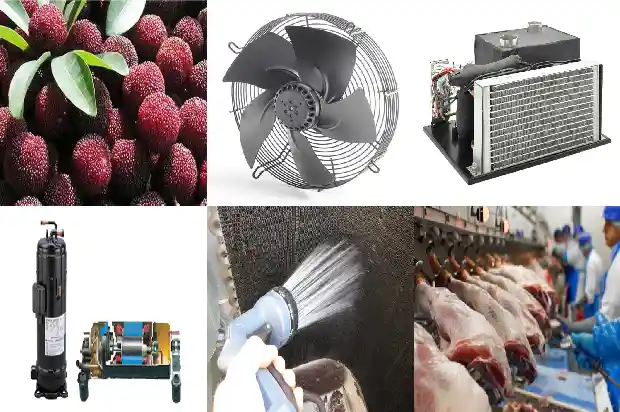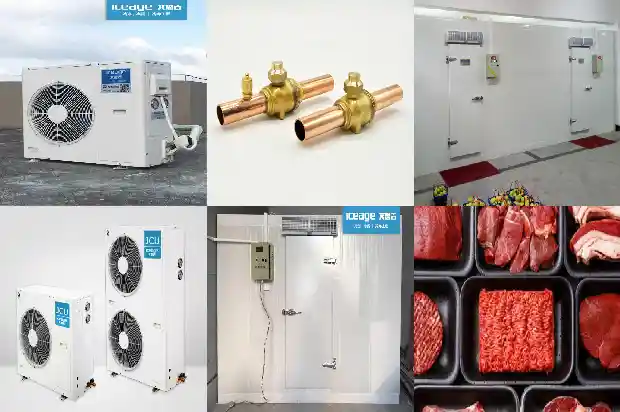Installation and Oil Return Precautions for Refrigeration Equipment Pipelines
2024-09-13
- For the horizontal suction gas pipeline along the direction of refrigerant flow, there should be a slope greater than 0.5%. The cross-section of the horizontal suction gas pipeline must ensure that the gas flow velocity is not less than 3.6 m/s.
- In the vertical suction gas pipeline, the gas flow velocity must be ensured to be not less than 7.6 - 12 m/s. A gas flow velocity greater than 12 m/s cannot significantly improve oil return, but will generate high noise and lead to a higher pressure drop in the suction gas pipeline.
- At the bottom of each vertical suction gas pipeline, a U-shaped oil return bend must be set up. If the height of the vertical suction gas pipeline exceeds 6 meters, a U-shaped oil return bend must be set up for every additional 6 meters. The length of the U-shaped oil return bend should be as short as possible to avoid accumulating too much oil.
- The return gas pipeline should incline towards the compressor with a slope of 3/1000. The exhaust pipeline should incline towards the condenser with a slope of 2/1000. The unit should be as close as possible to the cold storage evaporator. When the unit position is higher than the evaporator, an oil return bend needs to be set at the joint of the horizontal return gas pipe of the evaporator and the rising riser. If the unit position is much higher than the evaporator, an oil storage bend needs to be added for every 6-meter rising section.
If the unit position is lower than the evaporator, the oil storage bend at the bottom of the rising section should make the return gas pipe rise to be flush with the upper surface of the evaporator, and then go towards the unit. If the condenser position is higher than the compressor unit, for every 6 meters that the condenser is higher than the compressor unit, an oil return bend should be added to the rising section of the exhaust pipe. In addition, in a system where a structural valve without a one-way check oil return bend is not installed in the exhaust part, the exhaust rising pipe should be raised above the coil horizontal plane of the air-cooled condenser and then connected to the condenser. - When the system does not adopt the evacuation cycle, at the outlet of each evaporator, a U-shaped throttling bend should be set to prevent the liquid refrigerant from flowing into the compressor under the action of gravity when the unit is shut down.
- When the suction rising pipe is connected to the evaporator, a section of horizontal pipe and throttling bend should be left in the middle for installing the temperature sensor package to prevent the expansion valve from malfunctioning.
- When the compressor is higher than other positions in the system, an oil return bend should be set in the rising riser about 3 meters.
Also, the diameter of the return gas riser should be reduced to increase the flow velocity and bring the oil back to the compressor.
- Generally, the U-shaped bend added when the condenser is higher than the compressor is set to prevent liquid hammer and oil hammer caused by the condensation of working medium and the return of oil during shutdown when starting up next time. When the system pipeline is designed reasonably and the evaporator is lower than the compressor, consideration should be given to setting an oil return bend. To meet the oil-carrying speed, the pipe diameter can be appropriately reduced (especially in low-temperature conditions).
Generally, fully enclosed compressors allow a lifting height of 4 meters, and semi-hermetic compressors allow a lifting height of 6 meters. The slope of the horizontal pipeline is greater than 1:125. As long as the flow velocity of the refrigerant is greater than 4 m/s, the lubricating oil can be smoothly taken out.
For the problem of oil level balance in double-click parallel oil return, the installation also has very important considerations. Two compressors must be at the same horizontal position and have the same model (same power). The main oil return pipe must be evenly divided between the two units. The branch must adopt a "Y" shape. The branch pipes must have the same height, length, and pipe diameter to ensure the same oil distribution.
Then there is the issue of operation adjustment. For example, the suction pressures of the two machines should be exactly the same, and there must be no liquid slugging phenomenon. Otherwise, the oil will disappear immediately. If these cannot be guaranteed, then the oil return cannot be consistent.
Heat pump system:
Maintain a relatively high return gas temperature and pressure, and add a longer return gas pipeline; add a heat regenerator, etc. Control the opening degree of the throttle valve (expansion valve). When it is found that the compressor is frosted, the opening degree of the expansion valve should be adjusted in time to control the return steam pressure within a reasonable range.
About ten minutes before each shutdown, the liquid supply valve must be closed first to store the refrigerant in high-pressure components such as the condenser and liquid receiver. Continue to operate, reduce the liquid level in the evaporator, and then shut down to ensure that there is no liquid hammer phenomenon when starting up next time. Pay attention to return gas and oil return balance when in multi-stage parallel connection.
Related Articles
- Instructions for Welding and Drainage in the Installation of Refrigeration Equipment Pipelines
- What is the Correct Operation Method of the Distribution Box during Cold Storage Installation?
- What Issues Should Be Noted in Cold Storage Installation and Construction?
- What Special Requirements are There for the Installation of Tea Cold Storage?
- Operating Principle and Standard Installation Steps of Multi - split Systems in Refrigerant Air - conditioning Systems
- How to Identify the Quality of Refrigeration Equipment Installation Materials?
- How to Identify Installation Materials for Refrigeration Equipment
- Knowledge, Installation and Maintenance of Cold Storage Systems
- Precautions for the Installation and Use of Water Flow Switches
- What safety measures should be paid attention to during the installation of cold storage?
- What are the precooling methods after the installation of cold storage?
- Selection and Installation of Thermal Expansion Valves
- Return Bend Setup and Installation Technical Requirements
- Daily Maintenance Training for Users after Installation of Small and Medium-Sized Cold Storages
- Parallel Installation and Precautions for Scroll Compressors
- How to Select the Configuration for Cold Storage Installation?
- What inspections are required for central air conditioning installation?
- Introduction to Five Classification Functions of Cold Storage Installation for Refrigeration
